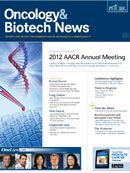Long-Term Hormonal Therapy May Pose Breast Cancer Risk
The long-standing debate about postmenopausal hormones and breast cancer gained more evidence to support an increased cancer risk.
Wendy Y. Chen, MD, PhD, MPH
The long-standing debate about postmenopausal hormones and breast cancer gained more evidence to support an increased cancer risk.
Women with a current history of long-term treatment with unopposed estrogen had as much as a 57% increased risk of invasive breast cancer compared with women who did not take hormones, according to a report presented at the 2012 AACR Annual Meeting. The risk doubled in women with a 10-year history of combined hormonal therapy and continued to increase with duration of therapy.
Extracted from the long-term Nurses’ Health Study (NHS), the data also identified subgroups of women with increased susceptibility to the potential cancer-related influences of hormonal therapy.
“The effects of hormonal therapy were stronger among thinner women and for hormone receptorpositive cancers,” said Wendy Y. Chen, MD, PhD, MPH, an oncologist at Dana-Farber Cancer Institute in Boston, Massachusetts, during an AACR press briefing.
“The results indicate that there is a persistent risk of breast cancer associated with long-term hormonal therapy,” she added. “The association with receptorpositive cancers suggests that past users of hormone therapy might want to consider chemoprevention with selective estrogen receptor modulators.”
The findings came from an analysis of NHS participants who were postmenopausal during 1980- 2008, a number that increased from 31,959 to 61,473 over the study period. Chen reported that 5631 study participants developed breast cancer during follow-up, and 844 of them died of breast cancer.
Investigators stratified the study population into quintiles by duration of hormone therapy. Ongoing use of combined estrogen-progestin therapy was associated with a breast cancer risk that increased with duration and did not appear to plateau. With fewer than 5 years’ use, the risk was 1.41 versus women who did not use hormones, increasing to 1.89 for 10-14.9 years, to 2.49 for 15-19.9 years, and to 2.56 for 20 or more years of ongoing therapy (P <.001 for trend).
A weaker but still significant trend emerged in an analysis of past use, reaching a maximum risk of 1.35 with ≥20 years of use. None of the individual quintiles achieved statistical significance versus women who did not use hormones, but the overall trend did (P = .005).
For users of unopposed estrogen, only ongoing treatment had a significant association with breast cancer. Use for less than 5 years was not associated with an increased risk. Among current users, the magnitude of risk increased from 1.11 for 5-9.9 years to 1.57 for 20+ years (P <.0001 for trend).
Among women with hormone receptor—positive breast cancer, ongoing estrogen-progestin therapy posed the greatest risk, increasing from 1.54 in association with less than 5 years’ use to 3.37 for 15- 19.9 years of ongoing treatment (P <.001 for trend). A weak trend toward increased risk was seen in women with receptor-negative breast cancer (P = .02).
Ongoing use of unopposed estrogen had a significant association with receptor-positive breast cancer, reaching a maximum of 1.67 for 15-19.9 years of therapy (P <.001 for trend). Current estrogen therapy also was associated with an increased risk of breast cancer in women who had a body mass index (BMI) <25, a risk that doubled among those who had been using estrogen for 20 years or longer (P <.0001 for trend). A weak trend with increasing use was observed in heavier women (1.33; P = .006).
Current use of combined hormonal therapy was associated with increased risk, regardless of BMI. Among women with BMI <25, the risk increased from 1.79 with <5 years to 3.22 for ≥20 years (P <.0001). Women with BMI ≥25 had a risk ranging from 1.45-2.43 compared with nonusers (P <.0001).
Neither unopposed estrogen nor combined hormonal therapy significantly influenced breast cancer mortality, said Chen.
Reference
Chen WY, Willett WC, Hankinson SE, Rosner BA. Presented at the American Association for Cancer Research Annual Meeting; March 31-April 4, 2012; Chicago, IL. Abstract LB-60.




